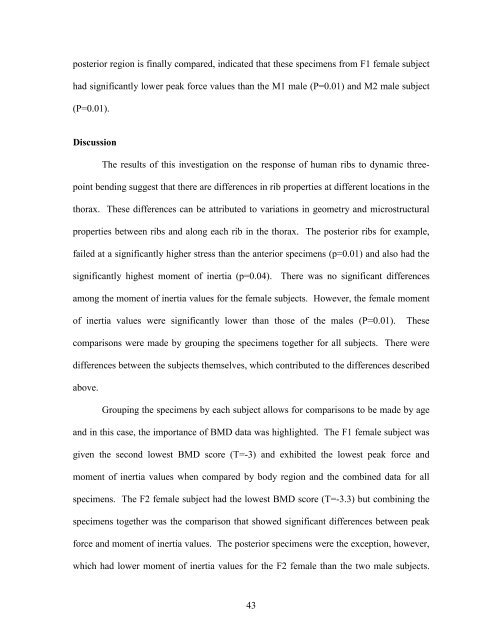Microstructural And Mechanical Properties Of Human Ribs Joseph
Microstructural And Mechanical Properties Of Human Ribs Joseph
Microstructural And Mechanical Properties Of Human Ribs Joseph
You also want an ePaper? Increase the reach of your titles
YUMPU automatically turns print PDFs into web optimized ePapers that Google loves.
posterior region is finally compared, indicated that these specimens from F1 female subject<br />
had significantly lower peak force values than the M1 male (P=0.01) and M2 male subject<br />
(P=0.01).<br />
Discussion<br />
The results of this investigation on the response of human ribs to dynamic three-<br />
point bending suggest that there are differences in rib properties at different locations in the<br />
thorax. These differences can be attributed to variations in geometry and microstructural<br />
properties between ribs and along each rib in the thorax. The posterior ribs for example,<br />
failed at a significantly higher stress than the anterior specimens (p=0.01) and also had the<br />
significantly highest moment of inertia (p=0.04). There was no significant differences<br />
among the moment of inertia values for the female subjects. However, the female moment<br />
of inertia values were significantly lower than those of the males (P=0.01). These<br />
comparisons were made by grouping the specimens together for all subjects. There were<br />
differences between the subjects themselves, which contributed to the differences described<br />
above.<br />
Grouping the specimens by each subject allows for comparisons to be made by age<br />
and in this case, the importance of BMD data was highlighted. The F1 female subject was<br />
given the second lowest BMD score (T=-3) and exhibited the lowest peak force and<br />
moment of inertia values when compared by body region and the combined data for all<br />
specimens. The F2 female subject had the lowest BMD score (T=-3.3) but combining the<br />
specimens together was the comparison that showed significant differences between peak<br />
force and moment of inertia values. The posterior specimens were the exception, however,<br />
which had lower moment of inertia values for the F2 female than the two male subjects.<br />
43



